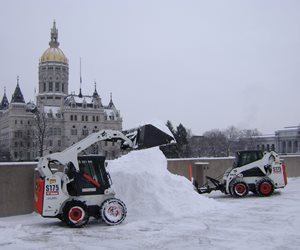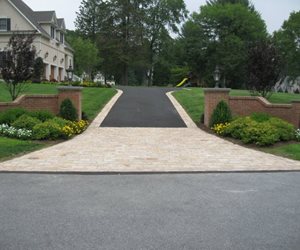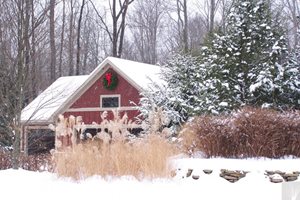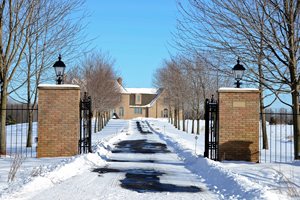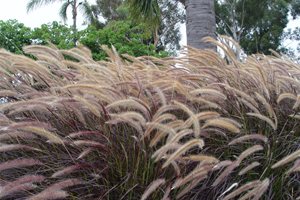Snow Plowing
Should you hire a snow management service for your home?Deicing products comparison
There are three basic types of deicing product: salts, which are the most corrosive, acetates, which are much healthier for landscape plants and wildlife, and sand, which is often used in combination with salts or acetates. The best products for your landscape will vary due to the current temperature, the materials in your landscape, and the proximity of landscaped areas.
Sand - "We use a sand-salt mix on driveways," says Gerry DuBreuil of Belknap Landscape Co., Inc in Gilford, NH. "It's about six parts sand to one part salt." Sand is less effective than salt or acetate, so is usually used in combination with another product.
Sodium chloride - Rock salt or sodium chloride is an inexpensive product, but it's considered one of the most corrosive and can damage plants and concrete. In addition, "rock salt is only effective to 18°," says DuBreuil.
Calcium chloride - This works well in temperatures as low as -25° and is less corrosive than sodium chloride, but can still damage concrete and plants.
Acetate products - DuBreuil favors acetate products. "Acetates can actually enhance plant life by acting as a nutrient," he says. They are effective in temperatures as low as -25° to -35°, making them a great choice for cold climates.
If you have a teenager around the house, you may not think it's worthwhile to pay for a snow management service. However, these professionals work all night long after a snowstorm to make sure your family can get to work or school in the morning. Here are some of the services a snow plowing company provides, and tips for saving money on your bill.
Snow management services
Clearing the driveway.
In most settings, your snow management crew will use a snow plow on the driveway, as it is the most efficient way of clearing snow. However, if you have a narrow drive or no place to push the snow with a plow, a snow blower may be used instead since it blows the snow over the landscaping rather than into a pile.
Clearing paths.
The front walkway is shoveled by hand or cleared with a mechanical broom. Don't use a metal snow shovel on surfaces that might scratch; instead choose a shovel with a rubberized edge, or a mechanical broom which won't damage hardscape.
Shoveling the roof.
In many cases, it's perfectly safe to leave the snow on your roof throughout the winter. However, if the snow is in danger of falling off the roof and blocking your front door, garage, or crushing landscape plants, you'll probably need the roof shoveled periodically.
Applying deicing products.
Once the snow has been cleared, it's important to apply a deicing product to keep your walk or driveway free of slippery ice.
Snow removal.
Most homeowners opt to have their snow piled on the lawn or the side of the driveway, but on smaller properties it may be necessary to actually remove the snow and dump it on another site. Snow removal is usually twice as expensive as simple snow plowing.
Dos and don'ts of snow management
Do keep landscaping back from the driveway.
Not only can landscaping be damaged by snow plows, but the area right next to the driveway is the easiest space to store snow piles through the winter.
Do mark the edges of the driveway.
"We recommend using a reflective pole or stake," says Joe Markell of Sunrise Landscape and Design in Sterling, VA. This helps your plow crew avoid damaging the landscaping.
Do dump snow piles on the lawn or side of the driveway.
Your driveway is designed to drain well, so is an effective place to put snow piles. The lawn is also a good choice, particularly if you can avoid walking on the lawn while it's still muddy in spring.
Do think about snow management from the start.
The landscape design process is the easiest time to plan for snow storage and clear access for snow management crews. If you make access difficult, you'll have a higher cost year after year for snow plowing or removal.
Don't put obstacles in the way of the plow.
Electric gates, light posts, or landscaping right next to the driveway makes it harder for your plow crew to work quickly, which raises the price. Plant lawn on both sides of the driveway to make snow management and storage easier.
Don't leave piles of snow on top of your drainage system.
The pile of snow can become a barrier which keeps rainfall from reaching the drainage system.
Don't choose a company solely based on price.
Many fly-by-night companies pop up in winter to shovel walks or clear drives. However, a careless technician can cause extensive damage in the landscape. It's worthwhile to hire a landscaper who is familiar with your property, or a certified member of SIMA (Snow and Ice Management Association).

 Backyards
Backyards
 Front Yards
Front Yards
